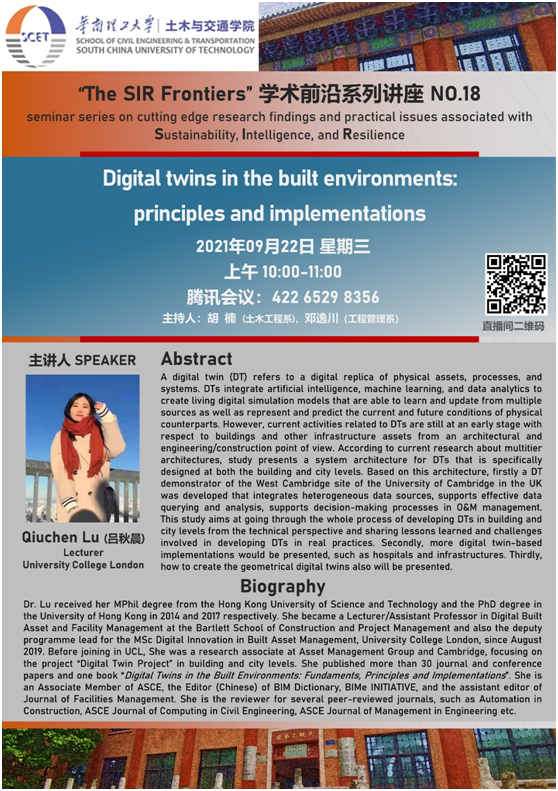题目:建筑环境中的数字孪生:原理与实施
Digital twins in the built environments: principles and implementations
时间:2021年09月22日周三10:00-11:00
地点:腾讯会议 ID:42265298356(若300人满请入直播间)
腾讯直播间:https://meeting.tencent.com/l/QALGLWoVMAcS
报告人:吕秋晨(英国伦敦大学学院)
欢迎广大师生参加!
土木与交通学院
2021年09月18日

报告人简介:
吕秋晨博士分别于2014和2017年获得香港科技大学硕士学位和香港大学博士学位,并自2019年8月以讲师(助理教授)身份任职于英国伦敦大学学院巴特利特可持续建筑学院,并担任建筑资产管理数字创新理学硕士(DIBAM)项目负责人。在加盟UCL之前,吕博士是英国资产管理集团(Asset Management Group)制造研究所的副研究员,还曾在剑桥大学工程系智能基础设施和建筑中心(CSIC)和英国数字建造中心(CDBB)工作。吕博士主要致力于建筑和城市层面的“数字孪生”项目,曾发表期刊会议论文30余篇并出版了一本著作,题为《Digital Twins in the Built Environments: Fundaments, Principles and Implementations》。吕博士目前是美国土木工程师学会(ASCE)的副会员、《建筑信息模型(BIM)词典》(中文)、BIMe INITIATIVE的编辑以及《设施管理杂志》的助理编辑。她还是诸如Automation in Construction, ASCE Journal of Computing in Civil Engineering, ASCE Journal of Management in Engineering多个高水平期刊的审稿人。
Dr. Qiuchen Lu became a Lecturer/Assistant Professor in Digital Built Asset and Facility Management at the Bartlett School of Construction and Project Management and also the deputy programmelead for the MSc Digital Innovation in Built Asset Management (DIBAM), University College London (UCL), since August 2019. Before joining in UCL, Qiuchen was a research associate based at Asset Management Group, Institute for Manufacturing (IfM), and also worked at the Centre for Smart Infrastructure and Construction (CSIC) and Centre of Digital Built Britain (CDBB), Department of Engineering, the University of Cambridge. Dr. Lu mainly focused on the project ‘Digital Twin (DT) Project’ in building and city levels in Cambridge. She received her MPhil degree from the Hong Kong University of Science and Technology and the PhD degree in the University of Hong Kong in 2014 and 2017 respectively. Dr. Lu published more than 30 journal and conference papers and one book, namely Digital Twins in the Built Environments: Fundaments, Principles and Implementations. Dr. Lu is currently an Associate Member of ASCE (The American Society of Civil Engineers), the Editor (Chinese Language) of Building Information Model (BIM) Dictionary, BIMe INITIATIVE, and the assistant editor of Journal of Facilities Management. She is the reviewer for several peer-reviewed journals, such as Automation in Construction, ASCE Journal of Computing in Civil Engineering, ASCE Journal of Management in Engineering etc.
报告摘要:
数字孪生指的是对实物资产、过程以及系统创建的数字模拟虚拟模型。数字孪生集成了人工智能、机器学习和数据分析等技术以创建实时数字仿真模型,模型能够从多个数据来源学习和更新以表现物理对象的当前状态并预测未来状况。然而在建筑工程及施工领域,数字孪生在相关的建筑和基础设施资产方面的应用还处于起步阶段。人们对于占据建筑全生命周期最长的运营维护阶段的数字孪生的关注则更是缺少。实现建筑和城市高效运营维护的首要步骤,就是需要建立一个经过实际使用验证的高系统化和清晰的模型架构。依据目前多层模型架构研究,吕博士及其团队设计了一种面向单体建筑以及城市层面的数字孪生系统。基于该系统,她们首先开发了剑桥大学西剑桥站点的数字孪生案例,该系统集成了异构数据源,能够进行高效的数据查询和分析,为运维管理中的决策提供支持,并进一步弥合人类与建筑物、城市之间的关系。本研究旨在从技术角度,贯穿建筑和城市层面开发数字孪生的整个过程,并分享在实际实践中开发数字孪生的经验教训和挑战。其次,吕博士将介绍更多基于数字孪生的实施案例,如医院和基础设施。最后,吕博士将介绍数字孪生的几何模型的创建方法。
A digital twin (DT) refers to a digital replica of physical assets, processes, and systems. DTs integrate artificial intelligence, machine learning, and data analytics to create living digital simulation models that are able to learn and update from multiple sources as well as represent and predict the current and future conditions of physical counterparts. However, current activities related to DTs are still at an early stage with respect to buildings and other infrastructure assets from an architectural and engineering/construction point of view. Less attention has been paid to the operation and maintenance (O&M) phase, which is the longest time span in the asset life cycle. A systematic and clear architecture verified with practical use cases for constructing a DT would be the foremost step for effective operation and maintenance of buildings and cities. According to current research about multitier architectures, our study presents a system architecture for DTs that is specifically designed at both the building and city levels. Based on this architecture, firstly a DT demonstrator of the West Cambridge site of the University of Cambridge in the UK was developed that integrates heterogeneous data sources, supports effective data querying and analysis, supports decision-making processes in O&M management, and further bridges the gap between human relationships with buildings/cities. This study aims at going through the whole process of developing DTs in building and city levels from the technical perspective and sharing lessons learned and challenges involved in developing DTs in real practices. Secondly, more digital twin-based implementations would be presented, such as hospitals and infrastructures. Thirdly, how to create the geometrical digital twins also will be presented.



